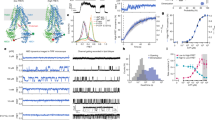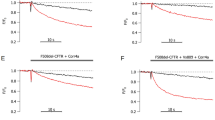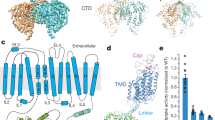Abstract
CFTR chloride channels are encoded by the gene mutated in patients with cystic fibrosis. These channels belong to the superfamily of ABC transporter ATPases. ATP-driven conformational changes, which in other ABC proteins fuel uphill substrate transport across cellular membranes, in CFTR open and close a gate to allow transmembrane flow of anions down their electrochemical gradient. New structural and biochemical information from prokaryotic ABC proteins and functional information from CFTR channels has led to a unifying mechanism explaining those ATP-driven conformational changes.
This is a preview of subscription content, access via your institution
Access options
Subscribe to this journal
Receive 51 print issues and online access
$199.00 per year
only $3.90 per issue
Buy this article
- Purchase on Springer Link
- Instant access to full article PDF
Prices may be subject to local taxes which are calculated during checkout





Similar content being viewed by others
References
Rommens, J. M. et al. Identification of the cystic fibrosis gene: chromosome walking and jumping. Science 245, 1059–1065 (1989).
Riordan, J. R. et al. Identification of the cystic fibrosis gene: Cloning and characterization of complementary DNA. Science 245, 1066–1073 (1989).
Quinton, P. M. Chloride impermeability in cystic fibrosis. Nature 301, 421–422 (1983).
Schoumacher, R. A. et al. Phosphorylation fails to activate chloride channels from cystic fibrosis airway cells. Nature 330, 752–754 (1987)
Li, M. et al. Cyclic AMP-dependent protein kinase opens chloride channels in normal but not cystic fibrosis airway epithelium. Nature 331, 358–360 (1988).
Bear, C. E. et al. Purification and functional reconstitution of the cystic fibrosis transmembrane conductance regulator (CFTR). Cell 68, 809–818 (1992).
Altschuler Y., Hodson C. & Milgram S. L. The apical compartment: trafficking pathways, regulators and scaffolding proteins. Curr. Opin. Cell Biol. 15, 423–429 (2003).
Li, C. & Naren, A. P. Macromolecular complexes of cystic fibrosis transmembrane conductance regulator and its interacting partners. Pharmacol. Ther. 108, 208–223 (2005).
Du, K., Sharma, M. & Lukacs, G. L. The DeltaF508 cystic fibrosis mutation impairs domain-domain interactions and arrests post-translational folding of CFTR. Nature Struct. Mol. Biol. 12, 17–25 (2005).
Wine, J. J. Acid in the airways. Focus on ‘Hyperacidity of secreted fluid from submucosal glands in early cystic fibrosis’. Am. J. Physiol. Cell Physiol. 290, C669–C671 (2006).
Davies, J. C. & Alton, E. W. Airway gene therapy. Adv. Genet. 54, 291–314 (2005).
Dean, M., Rzhetsky, A. & Allikmets, R. The human ATP-binding cassette (ABC) transporter superfamily. Genome Res. 11, 1156–1166 (2001).
Reyes, C. L. & Chang, G. Structure of the ABC transporter MsbA in complex with ADP.vanadate and lipopolysaccharide. Science 308, 1028–1031 (2005).
Locher, K. P., Lee, A. T. & Rees, D. C. The E. coli BtuCD structure: A framework for ABC transporter architecture and mechanism. Science 296, 1091–1098 (2002).
Rosenberg, M. F., Callaghan, R., Modok, S., Higgins, C. F. & Ford, R. C. Three-dimensional structure of P-glycoprotein: the transmembrane regions adopt an asymmetric configuration in the nucleotide-bound state. J. Biol. Chem. 280, 2857–2862 (2005).
Ramjeesingh, M., Kidd, J. F., Huan, L. J., Wang, Y. & Bear, C. E. Dimeric cystic fibrosis transmembrane conductance regulator exists in the plasma membrane. Biochem. J. 374, 793–797 (2003).
Raghuram, V., Mak, D. D. & Foskett, J. K. Regulation of cystic fibrosis transmembrane conductance regulator single-channel gating by bivalent PDZ-domain-mediated interaction. Proc. Natl Acad. Sci. USA 98, 1300–1305 (2001).
Chen, J. H., Chang, X. B., Aleksandrov, A. A. & Riordan, J. R. CFTR is a misnomer: Biochemical and functional evidence. J. Membr. Biol. 188, 55–71 (2002).
Zhang, Z. R. et al. Determination of the functional unit of the cystic fibrosis transmembrane conductance regulator chloride channel: One polypeptide forms one pore. J. Biol. Chem. 280, 458–468 (2005).
Dawson, D. C., Liu, X., Zhang, Z. & McCarty, N. A. in Cystic Fibrosis Transmembrane Conductance Regulator (eds Kirk, K. L. & Dawson, D. C.) 1–34 (Kluwer/Plenum, New York, 2003).
Linsdell, P. Mechanism of chloride permeation in the cystic fibrosis transmembrane conductance regulator chloride channel. Exp. Physiol. 99, 123–129 (2006).
Tabcharani, J. A., Chang, X. B., Riordan, J. R. & Hanrahan, J. W. Phosphorylation-regulated Cl− channel in CHO cells stably expressing the cystic fibrosis gene. Nature 352, 628–631 (1991).
Hung, L. W. et al. Crystal structure of the ATP-binding subunit of an ABC transporter. Nature 396, 703–707 (1998).
Hopfner, K. P. et al. Structural biology of Rad50 ATPase: ATP-driven conformational control in DNA double-strand break repair and the ABC-ATPase superfamily. Cell 101, 789–800 (2000).
Smith, P. C. et al. ATP binding to the motor domain from an ABC transporter drives formation of a nucleotide sandwich dimer. Mol. Cell 10, 139–149 (2002).
Chen, J., Lu, G., Lin, J., Davidson, A. L. & Quiocho, F. A. A tweezers-like motion of the ATP-binding cassette dimer in an ABC transport cycle. Mol. Cell 12, 651–661 (2003).
Zaitseva, J., Jenewein, S., Jumpertz, T., Holland, I. B. & Schmitt, L. H662 is the linchpin of ATP hydrolysis in the nucleotide-binding domain of the ABC transporter HlyB. EMBO J. 24, 1901–1910 (2005).
Walker, J. E., Saraste, M., Runswick, M. J. & Gay, N. J. Distantly related sequences in the alpha- and beta-subunits of ATP synthase, myosin, kinases and other ATP-requiring enzymes and a common nucleotide binding fold. EMBO J. 1, 945–951 (1982).
Moody, J. E., Millen, L., Binns, D., Hunt, J. F. & Thomas, P. J. Cooperative, ATP-dependent association of the nucleotide-binding cassettes during the catalytic cycle of ATP-binding cassette transporters. J. Biol. Chem. 277, 21111–21114 (2002).
Lewis, H. A. et al. Structure of nucleotide-binding domain 1 of the cystic fibrosis transmembrane conductance regulator. EMBO J. 23, 282–293 (2004) .
Lewis, H. A. et al. Impact of the deltaF508 mutation in first nucleotide-binding domain of human cystic fibrosis transmembrane conductance regulator on domain folding and structure. J. Biol. Chem. 280, 1346–1353 (2005).
Thibodeau, P. H., Brautigam, C. A., Machius, M. & Thomas, P. J. Side chain and backbone contributions of Phe508 to CFTR folding. Nature Struct. Mol. Biol. 12, 10–16 (2005).
Rosenberg, M. F. et al. Purification and crystallization of the cystic fibrosis transmembrane conductance regulator (CFTR). J. Biol. Chem. 279, 39051–39057 (2004).
Tabcharani, J. A. et al. Multi-ion pore behaviour in the CFTR chloride channel. Nature 366, 79–82 (1993).
Cotten, J. F. & Welsh, M. J. Cystic fibrosis-associated mutations at arginine 347 alter the pore architecture of CFTR. Evidence for disruption of a salt bridge. J. Biol. Chem. 274, 5429–5435 (1999).
Csanády, L., Chan, K. W., Nairn, A. C. & Gadsby, D. C. Functional roles of nonconserved structural segments in CFTR's NH2-terminal nucleotide binding domain. J. Gen. Physiol. 125, 43–55 (2005).
Cheng, S. H. et al. Phosphorylation of the R domain by cAMP-dependent protein kinase regulates the CFTR chloride channel. Cell 66, 1027–1036 (1991).
Picciotto, M., Cohn, J., Bertuzzi, G., Greengard, P. & Nairn, A.C. Phosphorylation of the cystic fibrosis transmembrane conductance regulator. J. Biol. Chem. 267, 12742–12752 (1992).
Csanády, L. et al. Preferential phosphorylation of R-domain Serine 768 dampens activation of CFTR channels by PKA. J. Gen. Physiol. 125, 171–186 (2005).
Neville, D. C. A. et al. Evidence for phosphorylation of serine 753 in CFTR using a novel metal-ion affinity resin and matrix-assisted laser desorption mass spectrometry. Protein Sci. 6, 2436–2445 (1997).
Berger, H.A., Travis, S. M. & Welsh, M. J. Regulation of the cystic fibrosis transmembrane conductance regulator Cl− channel by specific protein kinases and protein phosphatases. J. Biol. Chem. 268, 2037–2047 (1993).
Jia, Y., Mathews, C. J. & Hanrahan, J. W. Phosphorylation by protein kinase C is required for acute activation of cystic fibrosis transmembrane conductance regulator by protein kinase A. J. Biol. Chem. 272, 4978–4984 (1997).
Chappe, V. et al. Phosphorylation of protein kinase C sites in NBD1 and the R domain control CFTR channel activation by PKA. J. Physiol. 548, 39–52 (2003).
Rich, D. P. et al. Effect of deleting the R domain on CFTR-generated chloride channels. Science 253, 205–207 (1991).
Csanády, L. et al. Severed channels probe regulation of gating of CFTR by its cytoplasmic domains. J. Gen. Physiol. 116, 477–500 (2000).
Winter, M. C. & Welsh, M. J. Stimulation of CFTR activity by its phosphorylated R domain. Nature 389, 294–296 (1997).
Gadsby, D. C. & Nairn, A. C. Control of CFTR channel gating by phosphorylation and nucleotide hydrolysis. Physiol. Rev. 79, S77–S107 (1999).
Chang, X.-B. et al. Protein kinase A(PKA) still activates CFTR chloride channel after mutagenesis of all 10 PKA consensus phosphorylation sites. J. Biol. Chem. 268, 11304–11311 (1993).
Ostedgaard, L. S., Baldursson, O., Vermeer, D. W., Welsh, M. J. & Robertson, A. D. A functional R domain from cystic fibrosis transmembrane conductance regulator is predominantly unstructured in solution. Proc. Natl Acad. Sci. USA 97, 5657–5662 (2000).
Dulhanty, A. M. & Riordan, J. R. Phosphorylation by cAMP-dependent protein kinase causes a conformational change in the R domain of the cystic fibrosis transmembrane conductance regulator. Biochemistry 33, 4072–4079 (1994).
Wilkinson, D. J. et al. CFTR activation: additive effects of stimulatory and inhibitory phosphorylation sites in the R domain. Am. J. Physiol. 273, L127–L133 (1997).
Rich, D. R. et al. Regulation of the cystic fibrosis transmembrane conductance regulator Cl channel by negative charge in the R domain. J. Biol. Chem. 268, 20259–20267 (1993).
Aleksandrov, A. A., Chang, X., Aleksandrov, L. & Riordan, J. R. The non-hydrolytic pathway of cystic fibrosis transmembrane conductance regulator ion channel gating. J. Physiol. 528, 259–265 (2000).
Dulhanty, A. M., Chang, X.-B. & Riordan, J. R. Mutation of potential phosphorylation sites in the recombinant R domain of the cystic fibrosis transmembrane conductance regulator has significant effects on domain conformation. Biochem. Biophys. Res. Commun. 206, 207–214 (1995).
Xie, J., Zhao, J., Davis, P. B. & Ma, J. Conformation, independent of charge, in the R domain affects cystic fibrosis transmembrane conductance regulator channel openings. Biophys. J. 78, 1293–1305 (2000).
Travis, S. M., Carson, M. R., Ries, D. R. & Welsh, M. J. Interaction of nucleotides with membrane-associated cystic fibrosis transmembrane conductance regulator. J. Biol. Chem. 268, 15336–15339 (1993).
Aleksandrov, L., Aleksandrov, A. A., Chang, X. B. & Riordan, J. R. The first nucleotide binding domain of cystic fibrosis transmembrane conductance regulator is a site of stable nucleotide interaction, whereas the second is a site of rapid turnover. J. Biol. Chem. 277, 15419–15425 (2002).
Basso, C., Vergani, P., Nairn, A. C. & Gadsby, D. C. Prolonged nonhydrolytic interaction of nucleotide with CFTR's NH2-terminal nucleotide binding domain and its role in channel gating. J. Gen. Physiol. 122, 333–348 (2003) .
Ostedgaard, L. S., Rich, D. P., DeBerg, L. G. & Welsh, M. J. Association of domains within the cystic fibrosis transmembrane conductance regulator. Biochemistry 36, 1287–1294 (1997) .
Naren, A. P. et al. CFTR chloride channel regulation by an interdomain interaction. Science 286, 544–548 (1999) .
Chappe, V., Irvine, T., Liao, J., Evagelidis, A. & Hanrahan, J. W. Phosphorylation of CFTR by PKA promotes binding of the regulatory domain. EMBO J. 24, 2730–2740 (2005).
Anderson, M. P. et al. Nucleoside triphosphates are required to open the CFTR chloride channel. Cell 67, 775–784 (1991) .
Hwang, T.-C., Nagel, G. A., Nairn, A. C. & Gadsby, D. C. Regulation of the gating of CFTR Cl channels by phosphorylation and ATP hydrolysis. Proc. Natl Acad. Sci. USA 91, 4698–4702 (1994).
Vergani, P., Nairn, A. C. & Gadsby, D. C. On the mechanism of MgATP-dependent gating of CFTR Cl− channels. J. Gen. Physiol. 121, 17–36 (2003) .
Powe, A. C. J., Al-Nakkash, L., Li M. & Hwang, T. C. Mutation of Walker-A lysine 464 in cystic fibrosis transmembrane conductance regulator reveals functional interaction between its nucleotide-binding domains. J. Physiol. 539, 333–346 (2002).
Berger, A. L., Ikuma, M. & Welsh, M. J. Normal gating of CFTR requires ATP binding to both nucleotide-binding domains and hydrolysis at the second nucleotide-binding domain. Proc. Natl Acad. Sci. USA 102, 455–460 (2005).
Bompadre, S. G. CFTR gating II: effects of nucleotide binding on the stability of open states. J. Gen. Physiol. 125, 377–394 (2005).
Szabó, K., Szakács, G., Hegedus, T. & Sarkadi, B. Nucleotide occlusion in the human cystic fibrosis transmembrane conductance regulator. J. Biol. Chem. 274, 12209–12212 (1999) .
Davidson, A. L. & Chen, J. ATP-binding cassette transporters in bacteria. Annu. Rev. Biochem. 73, 241–268 (2004).
Higgins, C. F. & Linton, K. J. The ATP switch model for ABC transporters. Nature Struct. Mol. Biol. 11, 918–926 (2004).
Ramjeesingh, M. et al. Walker mutations reveal loose relationship between catalytic and channel-gating activities of purified CFTR (cystic fibrosis transmembrane conductance regulator). Biochemistry 38, 1463–1468 (1999) .
Gunderson, K. L. & Kopito, R. R. Conformational states of CFTR associated with channel gating: the role ATP binding and hydrolysis. Cell 82, 231–239 (1995).
Carson, M. R., Travis, S. M. & Welsh, M. J. The two nucleotide-binding domains of cystic fibrosis transmembrane conductance regulator (CFTR) have distinct functions in controlling channel activity. J. Biol. Chem. 270, 1711–1717 (1995).
Dousmanis, A. G., Nairn, A. C. & Gadsby, D. C. Distinct Mg(2+)-dependent steps rate limit opening and closing of a single CFTR Cl(−) channel. J. Gen. Physiol. 119, 545–559 (2002).
Mathews, C. J., Tabcharani, J. A. & Hanrahan, J. W. The CFTR chloride channel: nucleotide interactions and temperature-dependent gating. J. Membr. Biol. 163, 55–66 (1998).
Gunderson, K. L. & Kopito, R. R. Effects of pyrophosphate and nucleotide analogs suggest a role for ATP hydrolysis in cystic fibrosis transmembrane regulator channel gating. J. Biol. Chem. 269, 19349–19353 (1994).
Baukrowitz, T., Hwang, T.-C., Nairn, A. C. & Gadsby, D. C. Coupling of CFTR Cl channel gating to an ATP hydrolysis cycle. Neuron 12, 473–482 (1994).
Urbatsch, I. L., Sankaran, B., Weber, J. & Senior, A. E. P-glycoprotein is stably inhibited by vanadate-induced trapping of nucleotide at a single catalytic site. J. Biol. Chem. 270, 19383–19390 (1995).
Aleksandrov, A. A. & Riordan, J. R. Regulation of CFTR ion channel gating by MgATP. FEBS Lett. 431, 97–101 (1998).
Vergani, P., Lockless, S. W., Nairn, A. C. & Gadsby, D. C. CFTR channel opening by ATP-driven tight dimerization of its nucleotide-binding domains. Nature 433, 876–880 (2005).
Tombline, G., Bartholomew, L. A., Urbatsch, I. L. & Senior, A. E. Combined mutation of catalytic glutamate residues in the two nucleotide binding domains of P-glycoprotein generates a conformation that binds ATP and ADP tightly. J. Biol. Chem. 279, 31212–31220 (2004).
Mense, M., Nairn, A. C. & Gadsby, D. C. CFTR chloride channel activation in Xenopus oocytes by forskolin/IBMX promotes formation of a Rad50-like NBD1/NBD2 dimer. Biophys. J. 90, 310a (2006).
Lockless, S. W. & Ranganathan, R. Evolutionarily conserved pathways of energetic connectivity in protein families. Science 286, 295–299 (1999).
Kogan I. et al. CFTR directly mediates nucleotide-regulated glutathione flux. EMBO J. 22, 1981–1989 (2003).
Randak, C. O. & Welsh, M. J. Adenylate kinase activity in ABC transporters. J. Biol. Chem. 280, 34385–34388 (2005).
Gross, C. H. et al. Nucleotide binding domains of cystic fibrosis transmembrane conductance regulator, an ABC-transporter, catalyze adenylate kinase activity but not ATP hydrolysis. J. Biol. Chem. (in the press).
Muanprasat, C. et al. Discovery of glycine hydrazide pore-occluding CFTR inhibitors: mechanism, structure-activity analysis, and in vivo efficacy. J. Gen. Physiol. 124, 125–137 (2004).
Acknowledgements
This review and our research on CFTR were supported by grants from the NIH and Fogarty International Center (to D.C.G). We dedicate this review to our late colleague Benjamin Angel, MA, MB BS (3rd December 1978 to 2nd October 2005), whose courage and grace in the face of CF continue to inspire us.
Author information
Authors and Affiliations
Corresponding author
Ethics declarations
Competing interests
The authors declare no competing financial interests.
Additional information
Author Information Reprints and permissions information is available at npg.nature.com/reprintsandpermissions.
Rights and permissions
About this article
Cite this article
Gadsby, D., Vergani, P. & Csanády, L. The ABC protein turned chloride channel whose failure causes cystic fibrosis. Nature 440, 477–483 (2006). https://doi.org/10.1038/nature04712
Published:
Issue Date:
DOI: https://doi.org/10.1038/nature04712
This article is cited by
-
Recent advances in the biosynthesis of ribosomally synthesized and posttranslationally modified peptides of fungal origin
The Journal of Antibiotics (2023)
-
Understanding CFTR Functionality: A Comprehensive Review of Tests and Modulator Therapy in Cystic Fibrosis
Cell Biochemistry and Biophysics (2023)
-
Targeted quantitation of CFTR protein expression in vivo using immunoprecipitation & parallel reaction monitoring tandem mass spectrometry
Translational Medicine Communications (2022)
-
The NSAID glafenine rescues class 2 CFTR mutants via cyclooxygenase 2 inhibition of the arachidonic acid pathway
Scientific Reports (2022)
-
Systemic bis-phosphinic acid derivative restores chloride transport in Cystic Fibrosis mice
Scientific Reports (2022)
Comments
By submitting a comment you agree to abide by our Terms and Community Guidelines. If you find something abusive or that does not comply with our terms or guidelines please flag it as inappropriate.



